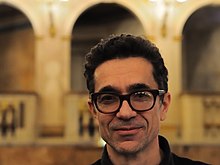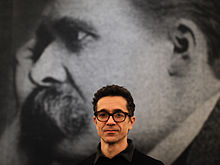| Romeo Castellucci | |
|---|---|
 | |
| Born | 1960 (age 64–65) Cesena, Italy |
| Occupation | Theatre director, playwright, artist, designer |
| Nationality | Italian |
| Period | 1981–present |

Romeo Castellucci (born August 4, 1960) is an Italian theatre director, playwright, artist and designer. Since the 1980s he has been one part of the European theatrical avant-garde.
Biography
Romeo Castellucci graduated with a degree in painting and stage design from the Accademia di Belle Arti di Bologna. In 1981, jointly with Claudia Castellucci and Chiara Guidi, he founded Socìetas Raffaello Sanzio.
Since then he has produced numerous plays as an author, director and a designer of sets, lighting, sound and costumes. His works, which combine multiple arts to achieve a holistic effect, have been presented in more than 50 countries. Castellucci’s dramatic lines challenge the primacy of literature. His theatre is a visual, complex art rich in vision. He has developed a language that is comprehensible in the same way as music, sculpture, painting and architecture can be.
Since 2006, Castellucci has been working individually. His productions are regularly invited to the world’s most prestigious theatres, opera houses and festivals.
Romeo Castellucci has released more than a dozen books and has received numerous awards and recognitions, amongst which:
- Europe Prize Theatrical Realities, with Chiara Guidi, awarded to Socìetas Raffaello Sanzio (Taormina, 2000)
- Best Opera Director (Opernwelt magazine, 2014)
- The Golden Lion for Lifetime Achievement (La Biennale Teatro di Venezia; 2013)
- Honoris Causa (Università di Bologna, 2014)
- Knight of the Order of Arts and Letters by the Ministry of Culture of the French Republic (2002)
- Prize for Best International Production for Genesi. From the Museum of Sleep (Dublin Theatre Festival, 2000)
- Ubu Prize (1997, 2000, 2004, and 2006 with special distinction).
- Masque d’Or Prize for best foreign play for Orestea (una commedia organica?)(Festival Theatre des Ameriques in Canada, 1996).
In 2003 he became director of the theatre section of the 37th edition of the Venice Biennale, and in 2008 he was one of two "associate artists" at the Festival d'Avignon, and created three pieces inspired by Dante's Divine Comedy.
Stage works
- Cenno (1981)
- Diade incontro a monade (1981)
- Persia-Mondo (1981)
- Popolo Zuppo (1982)
- I fuoriclasse della bontà (1983)
- Oratoria n.1: Rimpatriata Artistica (1983)
- Oratoria n.2. Raptus (1984)
- Oratoria n.3: Interferon (1984)
- Kaputt necropolis (1984)
- Glory glory, alleluja (1985)
- Santa Sofia. Teatro Khmer (1986)
- Oratoria n.4: Tohu Wa Bohu (Apparenze pre-mondiali) (1986)
- I Miserabili (1987)
- Oratoria n.5: Sono consapevole dell’odio che tu nutri per me (1987)
- Alla bellezza tanto antica (1988)
- Il gran reame dell’adolescenza (1988)
- La discesa di Inanna (1989)
- Gilgamesh (1990)
- Iside e Osiride (1990)
- Ahura Mazda (1991)
- Amleto. La veemente esteriorità della morte di un mollusco (1992)
- Le favole di Esopo (1992)
- Masoch. I trionfi del teatro come potenza passiva, colpa e sconfitta (1993)
- Hansel e Gretel (1993)
- Lucifero. Quanto più una parola è vecchia tanto più va a fondo (1993)
- Oratoria n.6: con evidenza per coloro che intendono (1993)
- Persona (1994)
- Festa plebea con Oratoria n.7: anche il peggiore può parlare, ma non deve farlo per me (1994)
- Le fatiche di Ercole (1994)
- Orestea (una commedia organica?) (1995)
- Buchettino (1995)
- Pelle d'asino (1996)
- Giulio Cesare (1997)
- Ophelia (1997)
- La prova di un altro mondo (1998)
- Genesi. From the Museum of Sleep (1999)
- Voyage au bout de la nuit (1999)
- Il Combattimento dai Madrigali guerrieri et amorosi, Libro VIII (2000)
- Tragedia Endogonidia (2002-2004)
- Crescite (2002-2004)
- Cryonic Chants (2004)
- Hey Girl! (2007)
- Divina Commedia: Inferno, Purgatorio, Paradiso (2008)
- Storia contemporanea dell'Africa. Vol. III (2008)
- Io penso (2010)
- Sul concetto di volto nel figlio di Dio (2010)
- Parsifal (2011)
- Il velo nero di pastore (2011)
- Persona (2011)
- Attore, il tuo nome non è esatto (2011)
- The Phenomenon Called I (2011)
- The Four Seasons Restaurant (2012)
- DAMMERUNG e NOTHUNG (2012)
- Folk (2012)
- Hyperion. Letters of a Terrorist (2013)
- Schwanengesang D744 - Canto del Cigno (2013)
- Natura e origine della mente (2013)
- Orphee et Eurydice (2014)
- The Rite of Spring (2014)
- Neither (2014)
- Ödipus der Tyrann de Friedrich Hölderlin, d’après Sophocle (2015)
- Moses and Aron (2015)
- St. Matthew Passion (2016)
- Democracy in America
- Tannhäuser (2017)
- Salome (2018)
- The Magic Flute (2018)
- Il Primo Omicidio (2019)
- Requiem (2019)
- Don Giovanni (2021)
- Bros (2021)
- Resurrection (2022)
Discography
- Il Terzo Reich – co-author Scott Gibbons (2022, LP, Xong collection, Xing, Italy)
Bibliography
- Colusso Tiziana, Società Raffaello Sanzio: Il Teatro Iconoclasta, Ravenna: Essegi, 1989.
- Castellucci Claudia & Castellucci Romeo, Il teatro della Socìetas Raffaello Sanzio. Del teatro iconoplasta alla super-icona, Milano: Ubulibri, 1992.
- Castellucci Claudia & Castellucci Romeo, Les Pèlerins de la matière. Théorie et praxis du théâtre. Écrits de la Socìetas Raffaello Sanzio, Besançon: Les solitaires intempestifs, 2001.
- Castellucci Romeo & Guidi Chiara & Castellucci Claudia, Epopea della polvere. Il teatro della Socìetas Raffaello Sanzio 1992-1999: Amleto, Masoch, Orestea, Giulio Cesare, Genesi, Milano: Ubulibri, 2001.
- Castellucci Romeo & Socìetas Raffaello Sanzio, Epitaph, Besançon: Les solitaires intempestifs, 2003.
- Tackels Bruno, Les Castellucci, Besançon: Les solitaires intempestifs, 2005.
- Castellucci Claudia & Castellucci Romeo & Guidi Chiara & Kelleher Joe & Ridout Nicholas, The Theatre of Socìetas Raffaello Sanzio, London: Routledge, 2007.
- Pitozzi Enrico & Sacchi Annalisa, Itinera: Trajectoires de la forme. Tragedia Endogonidia, Arles: Actes Sud, 2008.
- Papalexiou Elena, Romeo Castellucci, Socìetas Raffaello Sanzio: When Words turn to Matter, Athens: Plethron, 2009.
- Papalexiou Eleni, “Ecce Homo”, in Theater der Zeit, Berlin, Januar 2011.
- Papalexiou Eleni, “The body as dramatic material in the theatre of Romeo Castellucci”, in Prospero European Review. Theatre and Research, 2, 2011.
- Papalexiou Eleni, "Le corps comme matière dramatique dans le théâtre de Romeo Castellucci", in Utopie et pensée critique dans le processus de création, Besançon: Les Solitaires Intempestifs, 2012.
- Semenowicz Dorota, To nie jest obraz, Poznan: Fundacja Malta / Koproracja Ha!Art, 2013.
- Sacchi Annalisa, "Shakespeare per la Socìetas Raffaello Sanzio", Pisa, ETS, 2014.
- Dukanic Filip, L'esthétique de la disparition sur la scène contemporaine : Castellucci, Goebbels, Ikeda, doctoral dissertation, supervised by Joseph Danan and Jean-Marc Larrue, forthcoming in 2017. (in French)
- Di Matteo Piersandra (ed.),Toccare il reale. L’arte di Romeo Castellucci, Napoli: Cronopio, 2015. (ISBN 8898367139)
- Leifeld Denis, Performances zur Sprache bringen. Zur Aufführungsanalyse von Performern in Theater und Kunst, transcript, Bielefeld 2015. (in German; ISBN 978-3-8376-2805-0)
- Papalexiou Eleni, “The Dramaturgies of the Gaze: Strategies of Vision and Optical Revelations in the Theatre of Romeo Castellucci and the Socìetas Raffaello Sanzio”, in G. Rodosthenous (ed.), Theatre as Voyeurism. The pleasures of Watching, London: Palgrave-Macmillan, 2015.
- Papalexiou Eleni, “Nyx Teleia. Nella notte profonda del mondo greco antico”, in Piersandra Di Matteo (ed.), Toccare il reale. L’arte di Romeo Castellucci, Napoli: Cronopio, 2015.
- Kelleher Joe, The Illuminated Theatre: Studies on the Suffering of Images, London: Routledge, 2015.
- Papalexiou Eleni, “Romeo Castellucci, Go down, Moses”, in Peak Performances, Montclair State University, 9-12 June 2016.
- Figueira João Francisco, Laissez-vous toucher… A portrait by Romeo Castellucci, Lisbon, KKYM, 2018. (paper ISBN 978-989-54070-0-2; ebook ISBN 978-989-54070-2-6)
- Papalexiou Eleni, ‘Romeo Castellucci or the Visionary of the non-Visual’, in: The Great European Stage Directors, L. Van den Dries & T. de Laet (eds), London: Bloomsbury-Methuen, 2019, pp 87-117 & 204-212
References
- Papalexiou, Eleni & Xepapadakou, Avra (2017). About SRS, http://www.arch-srs.com/srs
- Papalexiou, Eleni (2012). "The Body as Dramatic Material in the Theatre of Romeo Castellucci". Utopia and Critical Thinking, Les Solitaires Intempestifs: 75–87.
{{cite journal}}: Cite journal requires|journal=(help) - Papalexiou, Eleni (2015). "The Dramaturgies of the Gaze: Strategies of Vision and Optical Revelations in the Theatre of Romeo Castellucci and the Socìetas Raffaello Sanzio". Theatre as Voyeurism. London: Palgrave-Macmillan: 50–68. doi:10.1057/9781137478818_3. ISBN 978-1-349-50235-6.
- "VIII Edizione". Premio Europa per il Teatro (in Italian). Retrieved 2022-12-27.
- "Europe Theatre Prize - VIII Edition - Reasons". archivio.premioeuropa.org. Retrieved 2022-12-27.
- "La Biennale di Venezia - Sofia Gubaidulina and Romeo Castellucci to receive Golden Lions". www.labiennale.org. La Biennale di Venezia. April 30, 2013. Retrieved 1 September 2013.
- "ROMEO CASTELLUCCI / SOCÌETAS RAFFAELLO SANZIO - ASSOCIATE ARTIST - EDITION 2008 - ARCHIVE - Festival d'Avigno". www.festival-avignon.com. Festival d'Avignon. August 2008. Retrieved 1 September 2013.
- "Castellucci mixes opera and reality". tvbrussel. 16 June 2014.
- "The Rite of Spring". Ruhrtriennale. Retrieved 27 May 2019.
- "Neither". Ruhrtriennale. Retrieved 27 May 2019.
- Sulcas, Roslyn (4 November 2015). "The Challenge of Schönberg's Opera 'Moses and Aron'". The New York Times.
- "Democracy in America".
- "Tannhäuser". Bayerische Staatsoper. Retrieved 27 May 2019.
- Barone, Joshua (3 August 2018). "A Cri de Coeur in a Pool of Milk: Decoding 'Salome' in Salzburg". The New York Times.
- "Die Zauberflöte".
- Barone, Joshua (3 February 2019). "At the Paris Opera, a Biblical Tale Told with Rothko and Children". The New York Times.
- "Requiem". 13 November 2018.
- "Don Giovanni". Salzburger Festspiele. Retrieved 27 May 2022.
- "Bros". SOCIETAS. Retrieved 27 May 2022.
- Woolfe, Zachary (8 July 2022). "At the Opera, Humans Bear Witness to Atrocity, or Ignore It". The New York Times.